Budae Jjigae (Army Stew). A hearty, savory, spicy stew packed with instant noodles, vegetables, spam, tofu simmered in a flavorful broth! A popular Korean dish ready in 30 minutes! My version is on the milder side (not mild enough for kids) but can be made spicier.
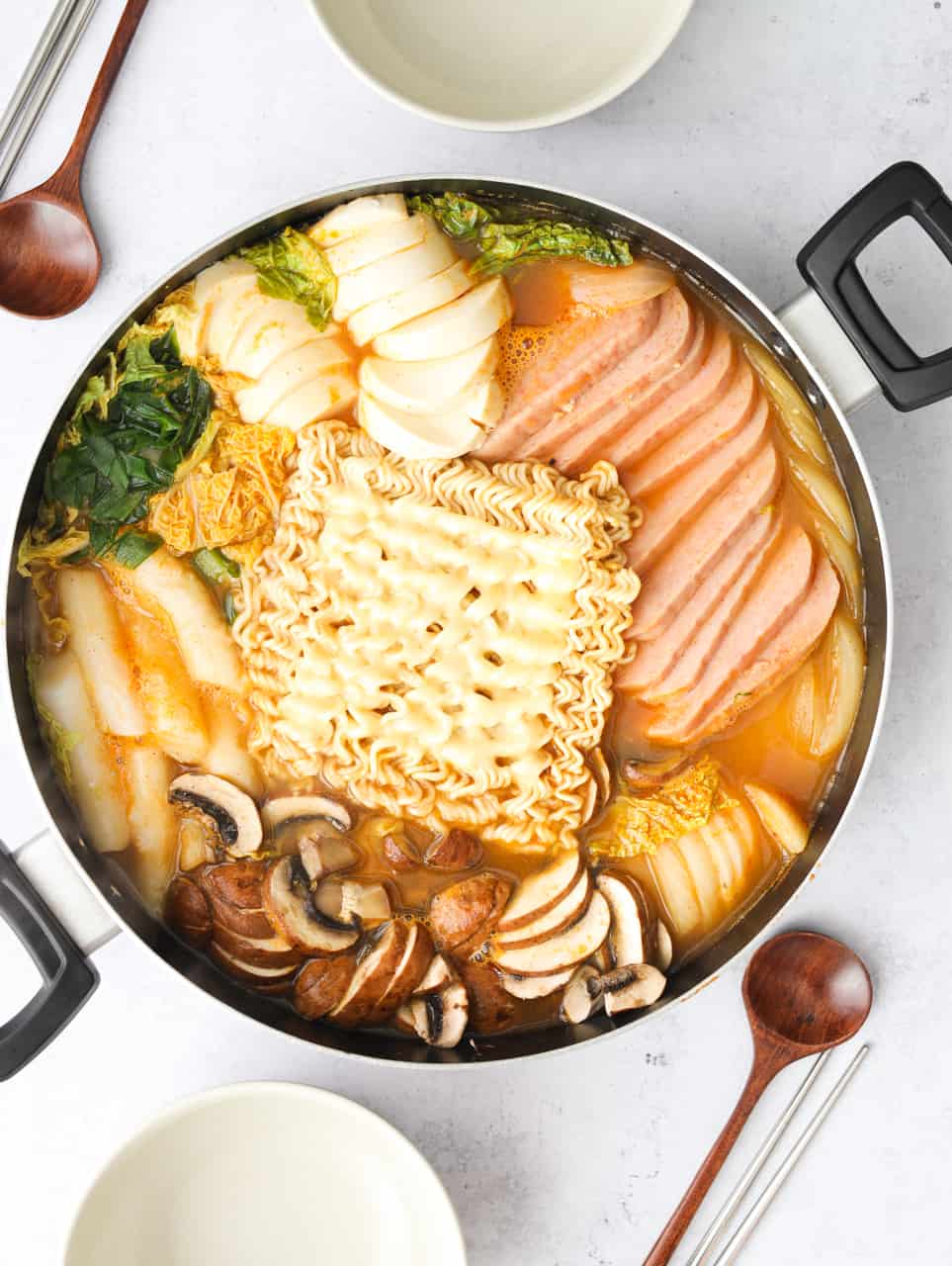
Jump to:
What is Budae Jjigae?
Budae Jjigae is a spicy Korean stew featuring instant noodles, spam, tofu, mushrooms, canned baked beans, cabbage, kimchi, rice cakes, onions and American cheese simmered in a savory broth.
It's absolutely delicious and super comforting! This stew is served as a main dish at many Korean restaurants and is served with steamed rice with Korean side dishes ('banchans' in Korean).
This popular stew is prepared in a shallow pot and cooked over a portable burner at the dinner table. It's one of the most iconic comfort foods in Korean cuisine thanks to the hearty ingredients and delicious broth.
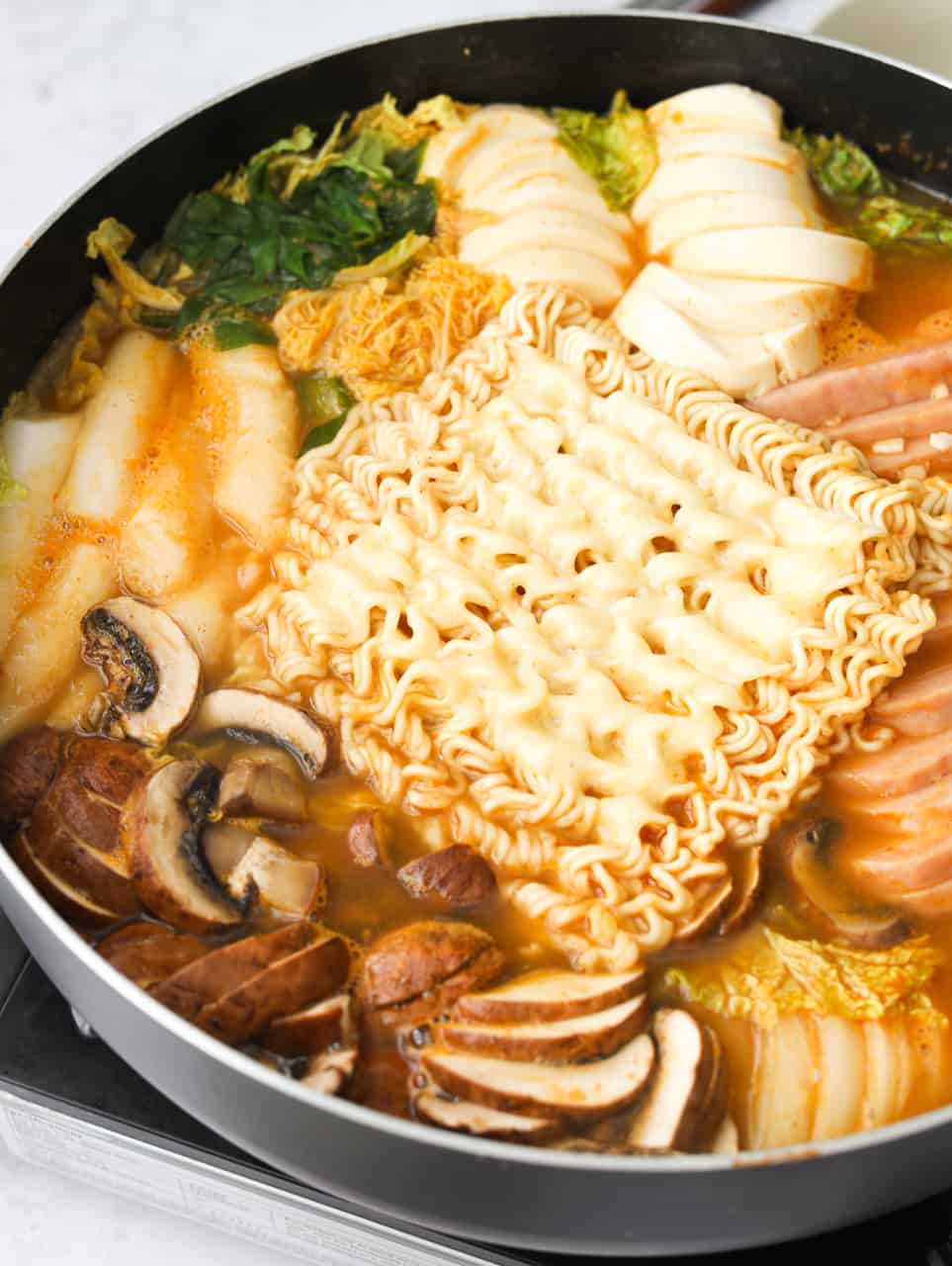
'Budae Jjigae' means 'Army Stew' in English translation. In the early 1950's during the Korean war, this dish was created in Uijeongbu, South Korea. The soldiers at the American military bases brought shelf stable foods from the United States, like canned spam and beans.
Since this created a surplus of food at the U.S. army bases, the Korean soldiers used these American ingredients with Korean ingredients to make this dish. That's why this dish is called "Korean Army Base Stew"!
I love making this dish because you can toss everything into a large pan to simmer and it's ready! It's even more wonderful to share with good company as you converse while enjoying the aroma of this bubbling stew.
Ingredients & Substitutes
Please scroll down to below recipe card for exact measurements.
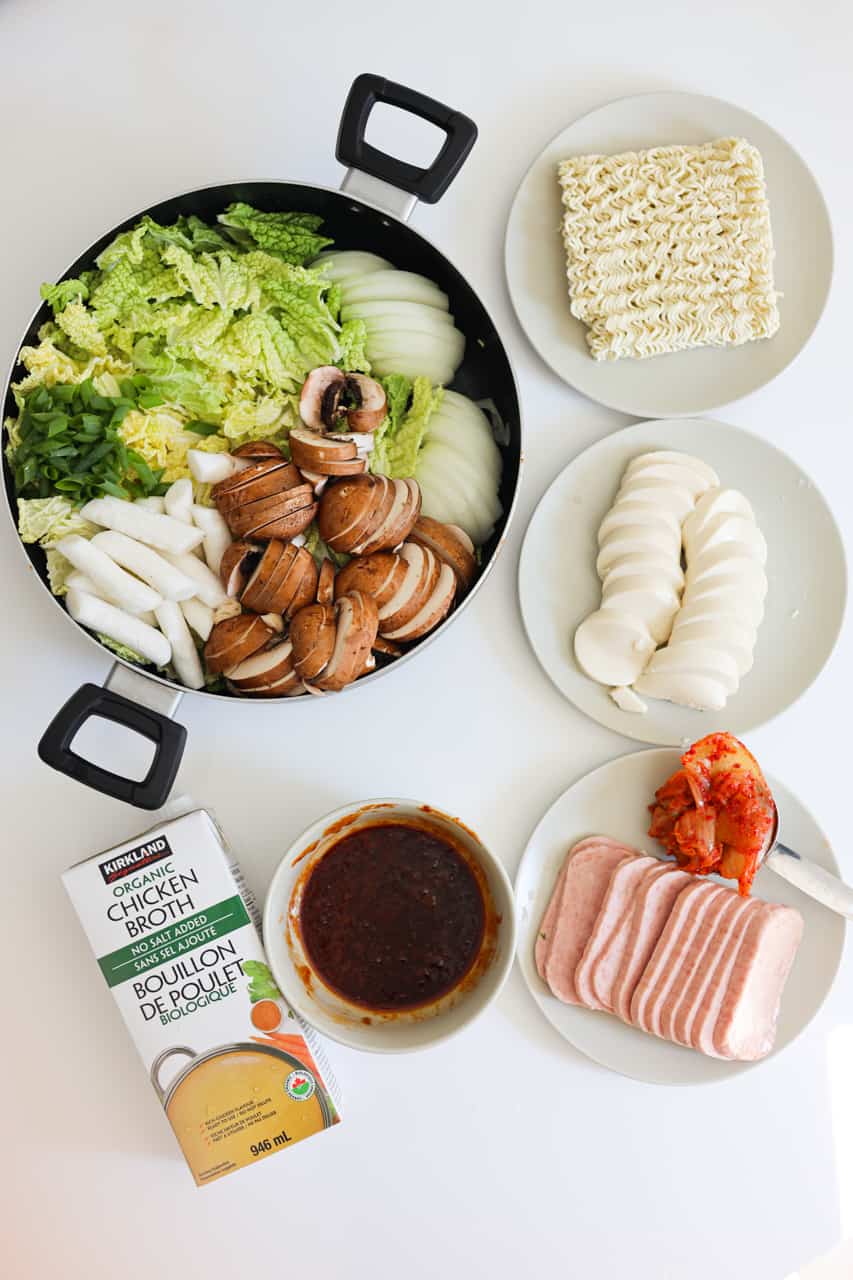
Note: Most Asian supermarkets will carry these ingredients. You may find some at your select grocery store or online, like on Amazon.
- Instant Ramen Noodles: I recommend using thicker instant noodles by a Korean brand but feel free to use any instant ramen noodles you enjoy.
- Spam: I recommend good old American spam for this delicious stew but feel free to substitute with hot dogs, ham, bacon, breakfast sausage or pork belly.
- Tofu: soft to firm tofu will work for this stew but for best taste, use soft tofu.
- Napa or regular cabbage: these greens work well as they have a mild flavor to offer to the soup base without overpowering it.
- Mushrooms: enoki mushrooms, king oyster, seafood mushrooms, or button mushrooms will all work for this dish!
- Maple-flavored baked beans: a can of sweet maple baked beans helps to balance the saltiness of this dish and tames the spice.
- Stock: traditionally anchovy stock is used to make this recipe but dashi stock, chicken stock, or vegetable stock can be used too.
- Onion
- Rice cakes: you can use the ones that look like flat circular medallions or the kind that are cylindrical tubes. I recommend using fresh ones or the refrigerated kind and avoid using the frozen kind as they easily splinter in the broth.
- American Cheese: cheddar or white cheese will work. It's iconic to this Korean Army Stew and also gives our stew a creamy flavor.
- Green onions
- Kimchi: use well fermented kimchi or old kimchi for the best budae jjigae! Older kimchi has a tangier, flavorful taste versus fresh kimchi.
Sauce
- Sesame oil: for that nutty flavor or omit if you're allergic.
- Gochujang paste: a Korean red chili paste made of red chili flakes, fermented soybean paste, glutinous rice and salt. It a thick red sweet and spicy paste that comes in a red tub sold at many Korean grocery stores in the sauce aisle. It comes in varying levels of spice from mild to hot. I recommend using the MILD kind and not the hot type.
- Regular soy sauce: or substitute with low sodium soy sauce or light soy sauce. If you’re gluten-free, substitute with tamari sauce, coconut aminos or a gluten-free soy sauce.
- Sugar: white granulated sugar, brown sugar, or cane sugar will work. You can even substitute with honey or any liquid sweetener of your choice.
- Garlic
Expert Tips
- I recommend using fresh vegetables for best taste.
- Pre-mix the sauce prior to adding it to the pan for an even taste distribution.
- Use a deep large pan so you can fit all the components along with the sauce and stock to prevent it from overspilling.
- For easy clean up, use a large deep non-stick pan as the rice cakes will stick to the bottom of the pan.
- If you're impressing guests, arrange the different components in groups as pictured below. This is optional.
- Add instant ramen last and boil for 2 minutes after the stew has boiled and your ingredients are cooked. This keeps the ramen chewy and springy so that you can enjoy it with the rest of your ingredients.
- Do not skipped the canned beans! The sweet beans offer a creamy depth to the broth. This also tones down the spiciness of the gochujang making it taste milder and helps to balance out the savory notes.
Instructions
Below are step-by-step instructions on how to make Budae Jjigae Army Stew:
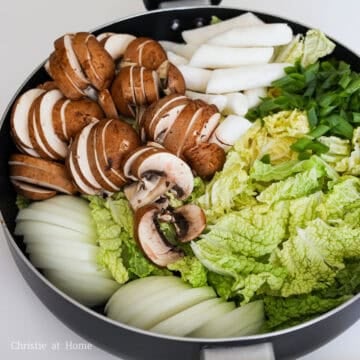
- Place prepared onion, green onion, cabbage, mushrooms, spam, tofu, maple baked beans, kimchi and rice cakes into large pan that is about 3 inches deep. Set aside.

- Next in a small bowl, whisk together your sauce ingredients until well combined. Pour the sauce and stock into the pan.
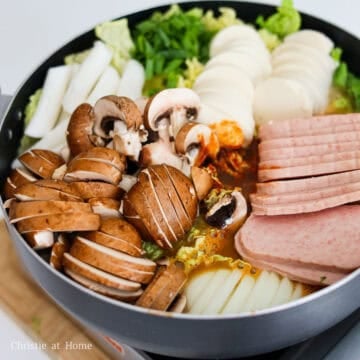
- Then place the pan over your stovetop or portable gas burner and boil over medium-high heat. Let the ingredients simmer in the stock for 10-15 minutes until the mushrooms soften, stirring occasionally. Feel free to cover with a lid if needed to speed up the process.
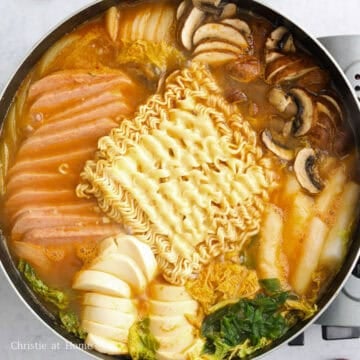
- Place instant ramen noodles on top of the stew with a slice of cheese on the noodles. Boil ramen for 2 minutes or until Al Dente texture. Depending on the size of your pan, you may need to boil the ramen cakes one at a time and remove cooked noodles from the broth so they don't get soggy. Enjoy the hot stew with steamed rice! If you want to keep the stew bubbling for guests, reduce the heat to the lowest setting possible uncovered.
Storage
- Budae jjigae is best consumed immediately. Leftovers can be stored in an airtight container and will last up to 2 days. However, I recommend removing any leftover noodles and storing the broth separate from the other components. To reheat, microwave for 2-3 minutes or reheat on the stovetop in a pan.
- Freezer-friendly? I don't recommend freezing army base stew as the vegetables and noodles will become mushy.
Pairing Suggestions
Budae jjigae serves well with Korean side dishes like:
FAQ
Yes, you can make the stew 1-2 days in advance (except for the instant ramen and cheese) and store the broth separate from the other ingredients in airtight containers in the fridge. When it's time to reheat, re-boil everything in a pot and then cook the instant ramen noodles and cheese in the stew for 2 minutes.
Other recipes you may like
📖 Recipe

Quick & Easy Mild Budae Jjigae (Korean Army Stew)
Ingredients
- 4 servings instant ramen noodles
- 12 oz spam sliced into 1 cm thick pieces (or sub with bacon, hot dogs, or ham)
- 1 lb tofu sliced into 1 cm thick pieces (soft to firm tofu)
- 5 cups napa cabbage or regular cabbage roughly chopped
- 2.5 cups mushrooms like enoki mushrooms, king oyster or button mushrooms sliced
- 13.45 fl oz baked beans maple flavoured
- ⅓ cup kimchi
- 1 small onion sliced thinly
- 1 cup Korean rice cakes
- 4 cups stock anchovy, dashi, chicken or vegetable stock will work
- 4 slices cheese cheddar, swiss or mozzarella work
- 1 green onion finely chopped
Sauce
- 2 teaspoon sesame oil
- 1 tablespoon regular soy sauce
- 2 tablespoon gochujang mild kind (add 1-2 tablespoon more if you prefer this spicier)
- 2 tablespoon white granulated sugar
- 2 cloves garlic minced
Instructions
- Place prepared onion, green onion, cabbage, mushrooms, spam, tofu, maple baked beans, kimchi and rice cakes into large pan that is about 3 inches deep. Set aside.
- Next in a small bowl, whisk together your sauce ingredients until well combined. Pour the sauce and stock into the pan.
- Then place the pan over your stovetop or portable gas burner and boil over medium-high heat. Let the ingredients simmer in the stock for 10-15 minutes until the mushrooms soften, stirring occasionally. Feel free to cover with a lid if needed to speed up the process.
- Place instant ramen noodles on top of the stew with a slice of cheese on the noodles. Boil ramen for 2 minutes or until Al Dente texture. Depending on the size of your pan, you may need to boil the ramen cakes one at a time and remove cooked noodles from the broth so they don't get soggy. Enjoy the hot stew with steamed rice!If you want to keep the stew bubbling for guests, reduce the heat to the lowest setting possible uncovered.


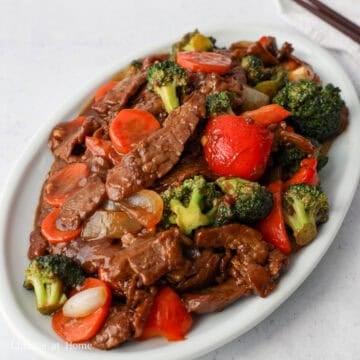

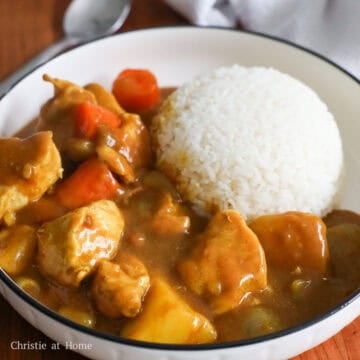

AliceK
Thank you for giving us a milder recipe that my whole family can enjoy! I like my food spicier than my husband, so I can always just add more gochujang to my bowl. But I do have a question. You have all the ingredients arranged in little piles in the cooking pot, but you say to stir while it is cooking. How do you stir without disturbing the arrangement?
Christie Lai
Thanks so much for making my mild budae jjigae, Alice! Glad the whole family enjoyed it! In answer to your question, unfortunately the arrangement will naturally have to be disturbed in order to stir it but I like to do is to wiggle the ingredients in the broth instead of doing a full circular stir if that makes sense.
Rosemary
Okay I was wondering if they actually ate this in the army! I love your history facts about how they used the processed meats in traditional Army Stew!